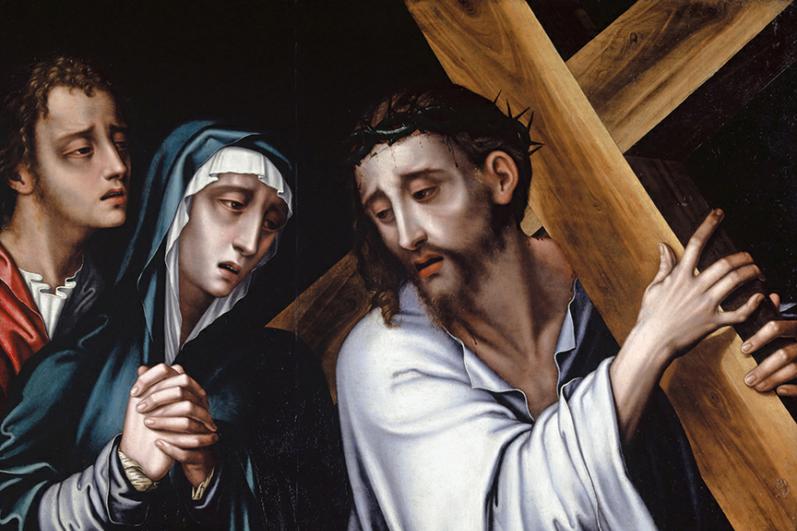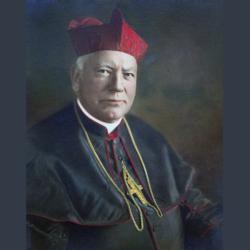God's instrument for viewing the crucifixion
The crucifixion is so horrible that we naturally recoil from it. Without some special reason to view it, we flee from it, just as the Apostles did at the event itself (except for John). Protest as much as we like that we are ready to die with him, our nature rebels, and we flee.
Our Protestant brethren prove that this is so. They understand that they must show piety towards the act which saved them. But, perhaps because they reject "This is my body" in the literal sense, they have no strong reason to re-imagine the corpus. Thus, they erect crosses only. They wear only crosses as pendants, never crucifixes.
The Catholic devotion of Stations of the Cross can be understood in this light. To go to a church for the stations is to bind ourselves, against our inclinations, to follow the distressing torture all the way to the end. We imitate Odysseus binding himself to the mast, but in this case, to keep us from avoiding, rather than pursuing.
According to tradition, Mary devised the stations in the yard of the household in Ephesus, where she lived with John. Pause and consider how astonishing this fact is. I have known mothers who have lost children. They save locks of hair and pictures. They remember times together. But they do not try to re-enact, on a regular basis, the last moments of their child's death.
But this was the woman who "treasured up all these things and pondered them in her heart" (Lk 2:19), who, by the prophecy of Simeon was told that "a sword will pierce your own soul -- to the end that thoughts from many hearts may be revealed" (2:35). If she paid at least as much attention to these words as we do, she must have understood that her special vocation was to contemplate, and by contemplating, to bring to us the crucifixion of her Son.
Apparently, she acted on this understanding. She did so by devising the stations. And we help her fulfill this vocation when we follow the stations ourselves.
Catholics say that Mary is a mediatrix of the redemption. Some take umbrage at this. They say: do not place anything between us and the Lord. But suppose that, practically speaking, we would not "get" to the Lord if we did not have some bridge, some connector, some means -- someone to draw us, someone to lead us in, someone (even) to buffer. Then, humility would require that we plead, rather: "Please give us this mediatrix, so that we can (after all) get to the Lord as we wish!"
This is the spirit in which, I think, we should understand that ancient hymn called after its first Latin words, "Stabat mater" ("The mother was standing"). In the hymn, we see the crucifixion precisely through its effects on Mary. Look carefully at its lyrics, and you will see that the hymn never asks us to look at the crucifixion itself. She is standing there next to the cross, in tears. A sword pierces her through while she looks upon the punishments her glorious son endures. She sees how Jesus has endured a terrible scourging. She sees "her sweet offspring, abandoned in death, as he gives up his spirit." But we never see any of this: we see her seeing it.
In Catholic tradition, the Son is likened to the sun, and Mary to the moon. We look upon Mary in the way that we look at the sun in a reflection. And then, when the Son dies, the sun dies -- "a darkening of the sun!" (Lk 23:44) -- so that it remains for us only to ponder the divinely appointed reflectrix, who "was standing there."
If we are slow to feel passion at The Passion, Mary can help us. "How sad and afflicted that blessed woman was!" the hymn says, "Who is the man who is incapable of weeping, upon seeing the very Mother of Christ immersed so deeply in suffering? Who can fail to feel sorrow along with her, when he contemplates the pain that the Mother of Christ shares with her Son?" Mary strangely attracts us to the pain. She binds us to his suffering.
Protestant critics of Marian devotion say that Catholics worship Mary. Really? Attend to the petitions at the end of this great hymn:
"Mother, fountain of love, make me feel the power of your sorrow, that I might mourn with you!
"Holy Mother, this is my request: fix firmly in my heart the wounds of the Crucified One!
"Divide up with me the punishments of your wounded Son, who deigned to suffer for me!
"Make me weep piously along with you. Make me, like you, suffer with him on the cross, for as long as I shall live!
"This I desire: that through my own grieving I might stand next to the Cross keeping company with you!
"Make it so that I become injured by his wounds; make it so that I become drunk by the Cross and by the blood of your Son!"
The Latin of the Stabat Mater is so beautiful that someone might reasonably wish to learn Latin simply to read it. The hymn has been graced by two musical settings which rank as great masterpieces: those of Palestrina and Pergolesi.
Not a movie, but Mary is God's instrument for viewing the Crucifixion.
- Michael Pakaluk, an Aristotle scholar and Ordinarius of the Pontifical Academy of St. Thomas Aquinas, is a professor in the Busch School of Business at the Catholic University of America. He lives in Hyattsville, MD, with his wife Catherine, also a professor at the Busch School, and their eight children. His latest book is "Mary's Voice in the Gospel of John" available from Amazon.



















